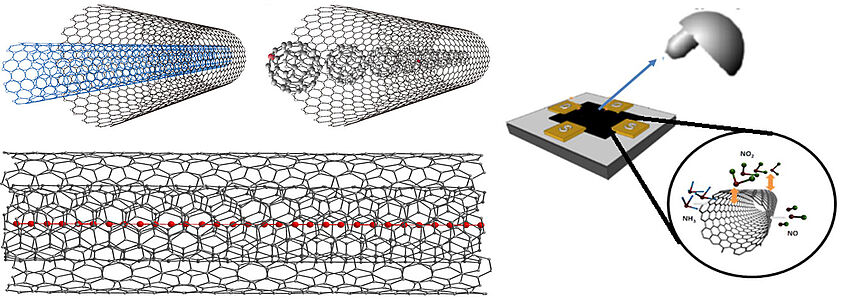Advanced Spectroscopy in 1D/2D Hybrid Systems

Left: Examples for tailored filled CNTs: Sketches for DWCNTs and heterofulleren as well as carbine.
Right: New types of 1D hybrid structures will be incorporated in bio and environmental sensing. The development of the techniques is envisaged.
Advanced Spectroscopy in 1D/2D Hybrid Systems
Controlling the function on an atomistic scale for bulk scale synthesis and functionalization processes of new 1D/2D materials is the key for their application. Among all new materials, low-dimensional carbon allotropes, exhibit outstanding properties and a leading applicability in fields ranging from materials science, solid state physics, physical chemistry to biochemistry and medicine. Especially, 1D allotropes, either as cylindrical 1D quantum wires (nanotubes (CNT)), or as ultra-long 1D chains (carbyne) offer unique possibilities.
The level of control and understanding of these materials will be strongly linked with the level at which they can be integrated in applications. The versatility allowed by new materials for testing new physical phenomena cannot be disregarded.
By use of cutting edge spectroscopy setups (PORTES and Raman facilities) utilizing the theoretical- and nanostructural analysis tools available to challenge to-date tangible limits of these 1D nano materials.
In this focus we concentrate on tailoring structure, environment, defects, functionalization and basic correlations to provide experimental key parameters to verify contemporary predictions of ab-initio theory and pinpoint optimization routes towards specific applications such as sensors or optoelectronic devices.
As a final goal, we access the applicability of materials with tailor made functional sites towards tests of prototype sensors for biological systems profiting from the optical response of the testing elements in non-invasive imaging techniques, as well as the integration of the same structures of similar materials on gas sensors.
